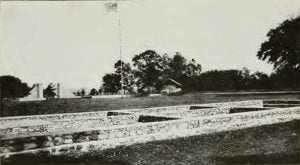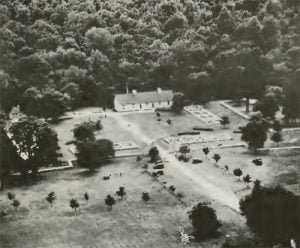The history of Prairie du Rocher is richly mingled with the early history of Fort de Chartres and the Catholic Church. To gain an insight to pre-settlement days one must turn back the calendar to the year 1682, when La Salle beached an expedition at the mouth of the Mississippi for King Louis XIV of France. La Salle secured the fleur de lis, and claimed the territory on the Illinois and Mississippi sides of the river for France. Later, La Salle interested the king in building a series of forts linking the French colonial territories in Canada and Louisiana.
Originally, the Illinois Country was under the jurisdiction of the Canadian province of Quebec, but in 1717 it was transferred as a district to the province of Louisiana. The first commandant of the Illinois Territory was Pierre Duque Boisbriant who arrived in December of 1718 with orders to govern the country and erect in the Mississippi a bastion to forestall possible aggressions of the English and Spanish as well as to protect the settlers from hostile Indians, With alacrity he started to build the most pretentious in the chain of forts along the Mississippi, Fort Due de Chartres – named in honor of the regent of France. This palisaded log fortification, completed in 1720 and located on the river about sixteen miles northwest of Kaskaskia, served as the headquarters of the civil, the military and the marine government of the Illinois Territory.

Shortly after the completion of the fort, a village – Nouvelle Chartres – grew nearby. Settlers from Canada and France, confident of protection, arrived and clustered near the fort. They wondered whether the native Indians could be trusted. While the local Metchagamia tribe in the vicinity of the fort proved to be anything but warlike, in 1729, the Natchez Indians, provoked by the tyranny and greed of the French commandant, Chobart – incited a conspiracy against the French. Massacres were frequent. In 1736 the garrison of Fort Chartres marched against the Chickasaw Indians, who threatened to cut communications between the Illinois Country and the city of New Orleans.
The focal point of this little French community of Nouvelle Chartres was the parish church of St. Anne du Fort de Chartres.
Fort Chartres was the creation of the Company of the West, or Mississippi Company, which was organized by the celebrated John Law, in August, 1717, immediately after the surrender by the Sieur Antoine Crozat of his patent and privileges in Louisiana to the French crown. This commercial company and its early successor, the Royal India Company, held away in the province of Louisiana, of which Illinois formed a part for fourteen years.
On the 9th of February, 1718, three ships of the Western Company – the Dauphin, Virilante, and Neptune – arrived at Dauphin Island with officers and men to take possession of Louisiana. On one of these vessels, or on the frigate La Duchesse de Noailles, which arrived at Ship island on the 6th of March following, came Pierre Duque de Boisbriant, a French Canadian, who had been commissioned first king’s lieutenant for the province of Louisiana, and who was the bearer of a commission appointing his cousin, LeMoyne de Bienville, governor and commandant general of the province, in place of M. L’Epignoy removal.
In the early part of October, 1718, Lieutenant Boiabriant, with several officers and a considerable detachment of troops, departed by bateau (boats) from Biloxi, through lakes Pontchartrain and Maureeas and up the Mississippi to regulate affairs in the Illinois county and to establish a permanent military post for the better protection of the French inhabitants in their northern district of the province. Arriving at Kaskaskia late in December of that year he established his temporary headquarters, which was the first military occupation of the village. This however, was continued for only about 18 months.
Having selected what was considered a convenient site for his post, some 18 miles above and to the northwest of Kaskaskia, de Boisbriant brought thither a large force of mechanics and laborers to work in the forest.
In the spring of 1720 they had built and practically completed the fort, which was hence forward the headquarters of the company and commandants and the center of both civil and military authority in Illinois.

The fort stood on the alluvial bottom about 3/4 of a mile from the Mississippi River and near to an older fort that had been erected by the adventures under Crozat. Midway between it and the bluffs on the east extend a bayou of lake which was supposed to add to the strategic strength of the place. It was named Fort de Chartres presumably in complyment to the Regent of France, from the title of his son, the Due de Chartres.
The fort was built of wood and was a very considerable size, but whether it was furnished with bastions or not is uncertain. It is described as a stockade fort, fortified with earth between the rows of palisades. Within the enclosure were erected the commandants house, the barracks, the large storehouse for the company, etc., the same being constructed of hewed timbers and ship-sawed planks.
Although not a strong fortification, except as against Indian attacks, it was made to answer for a full generation the needs of its builders and its commandants who successfully ruled here. It formed, moreover, an important link in the lengthened chain of French post stretching from eastern Canada to the Gulf of Mexico. The idea of this long line of military and trading posts appears to have originated in the fertile brain of that explorer, Robert CavelierSieur de la Salle. Poor maintenance and frequent flooding caused this fort to be abandoned. In 1732, a second wooden fort was built about one-half mile north of Fort No. 3. By 1747, the second fort was virtually useless because of rotting timbers. The impending signs of war with England pointed out the need for something more substantial. Therefore, the third fort, of stone, was started in 1753.
France lost the French and Indian War in 1763. But because of the trouble with the Ottawa Chief Pontiac, the British renamed Chartres – Fort Cavendish. After a severe flood in 1772, Fort Cavendish/Chartres was abandoned forever.
1970’s Programming at Fort de Chartres State Park

Since the Interpretive Program was started at Fort de Chartres a little over two years ago, many changes have occurred at the park. The Visitor Center/Museum has been re-vamped and plans have now been submitted for its expansion into the present Park Ranger’s residence when the Ranger has been relocated in a nearby house. The expanded Center will have more informative and participatory exhibits, through which visitors can utilize all their senses, not just sight and touch.
Plans have also been drawn up for the refurnishing of the Guard’s House with replica period pieces based on available data of the original fort. Completion should take about two years. The Priest’s Lodge is already refurnished. Restoring and furnishing buildings will continue for many years.
This summer, in addition to the Third Annual Rendezvous to be held June 17 and 18, archaeological work will be continued. Last year an Indian village north of the stone fort was excavated, and there was some preliminary exploration of the site of the first wooden fort. This year a six weeks’ archaeological dig will be conducted in the Powder Magazine and surrounding bastion. Archaeologists will be searching for remains of wall supports in the bastion to aid in the proposed restoration of the wall, evidence of a stone floor buried under the present wood floor in the Magazine, the location of a possible well site in front of the Magazine, and the location of one of the fort’s latrines. Also, it is hoped that the artifacts found in the excavation will shed additional light on the culture of the 18th century French and British soldiers once stationed here.
Our French herb garden has been expanded this year to include twenty-one varieties of herbs in use by the 18th century French in this area. An herb booklet explaining the varied uses of these herbs will be available to the public at the Visitor Center.
At present, the Visitor Center hours are 9:30 – 5:00 Wednesday through Sunday. When additional interpretive staff are hired, the Center will be open seven days a week. Guided tours are available Wednesday through Friday, by pre-arrangement only, for groups of fifty and under. To arrange for a guided tour, call 28-7230 Wednesday through Sunday. On Saturday and Sunday, tours are regularly scheduled for the public at 11:30 and 2:00. Those wishing to take a self-guided tour may obtain a tour booklet in the Visitor Center when-ever it is open.
In order to visit the Fort de Chartres State Park see their website: Fort de Chartres
